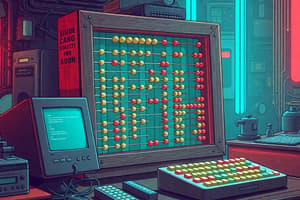Podcast
Questions and Answers
Who invented the first mechanical calculator?
Who invented the first mechanical calculator?
Blaise Pascal
The Pascaline was made up of electronic components.
The Pascaline was made up of electronic components.
False (B)
What type of operation did the Pascaline perform faster than the Abacus?
What type of operation did the Pascaline perform faster than the Abacus?
- Division
- Multiplication
- Subtraction
- Addition (correct)
What did the Leibniz Wheel extend the Pascal calculator to do?
What did the Leibniz Wheel extend the Pascal calculator to do?
The Jacquard Loom was an early example of network computing.
The Jacquard Loom was an early example of network computing.
What was the first generation of computers built using?
What was the first generation of computers built using?
Which component was used in second-generation computers?
Which component was used in second-generation computers?
What was one of the key features of third-generation computers?
What was one of the key features of third-generation computers?
What is cloud computing?
What is cloud computing?
Fourth generation computers used small-scale integrated circuits.
Fourth generation computers used small-scale integrated circuits.
Flashcards are hidden until you start studying
Study Notes
Introduction to Computing
- Computers are ubiquitous, found in schools, workplaces, homes, and businesses.
- Early mechanical calculators included the Pascaline, invented by Blaise Pascal in 1642, facilitating addition and subtraction faster than the abacus.
- Gottfried Wilhelm Leibniz developed the Leibniz Wheel in 1685, enhancing the Pascaline with automatic multiplication and division through a stepped drum mechanism.
Significant Inventions
- The Jacquard Loom, created by Joseph Marie Jacquard in 1804, automated cotton weaving using punched cards, a precursor to modern programming techniques.
- The abacus, dating back to around 3000 BC, was the earliest mechanical device for calculations, utilizing beads on rods, and remains in use today for teaching basic arithmetic.
Evolution of Computers
- The evolution of computing transitions from the Mechanical Era (1450-1840) to the Electronic Era (1940-present).
First Generation (1946-1959)
- Utilized vacuum tubes for memory and Central Processing Unit (CPU).
- Input and output methods included punched cards, paper tape, and magnetic tape.
Second Generation (1959-1965)
- Introduced transistors, which were cheaper, consumed less power, and were more compact than vacuum tubes.
Third Generation (1965-1971)
- Integrated Circuits (ICs) were developed by Jack St. Clair Kilby, revolutionizing computer design and efficiency.
Fourth Generation (1971-1980)
- Very Large-Scale Integrated Circuits (VLSICs) made computers more powerful, reliable, compact, and affordable.
Networking and Cloud Computing
- Computer networks consist of linked computers that share data and resources.
- Cloud computing provides access to information, applications, communication, and storage over the internet.
Studying That Suits You
Use AI to generate personalized quizzes and flashcards to suit your learning preferences.




